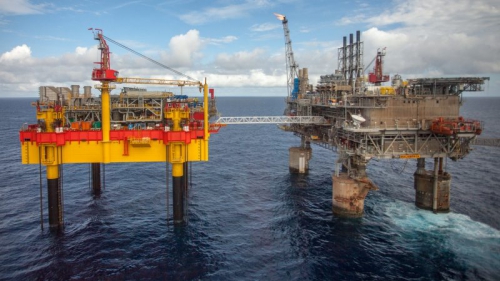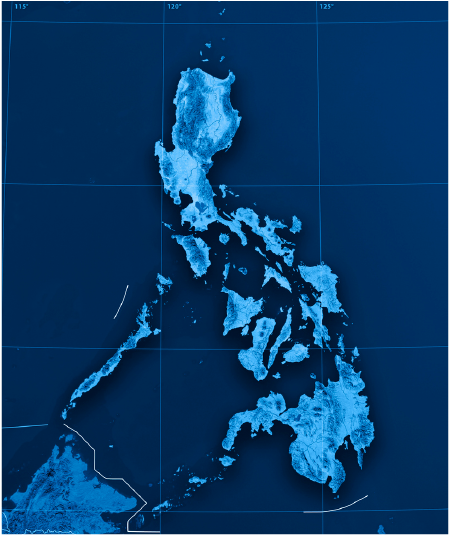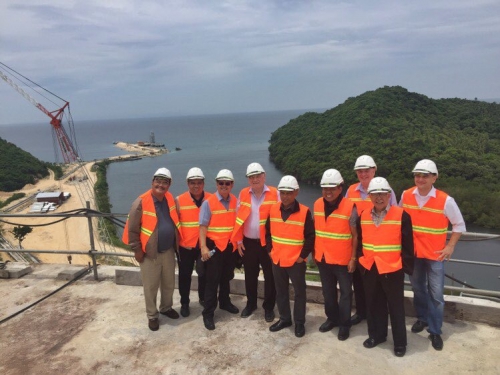[NGW Magazine] Philippines Aims at LNG
The Philippines’ energy ministry has established a new policy framework that it hopes will encourage global investors to take on an estimated $2bn worth of LNG infrastructure build-out.
The country needs to keep gas-fired generating assets viable – and attract new investments – after Malampaya, the country’s only commercial gas field, dries up in the next five or six years.
The build-out represents an entirely new investment cycle for the global energy sector, and it’s unclear whether the new policy framework will go far enough in convincing investors to take a gamble on gas in the Philippines.
The investment targets mapped out by the energy ministry are ambitious, and include talks of eventually establishing a major LNG trading and trans-shipment hub for the entire Asia-Pacific region.

Malampaya gas field (Credit: Shell)
The new policy, Philippine energy minister Alfonso Cusi told NGW, “will serve as the regulatory framework in the promotion of the Philippines as an LNG emerging market, characterised by a liberalised/competitive environment and market-based pricing.”
But investors appear less optimistic, given the scale of LNG investment that would be needed to push LNG into a stronger position in the country’s energy mix, which is still dominated by coal.
They are also disappointed that the policy framework failed to address those elements that investors have been yearning for: measures to curb further investments in coal-fired generating capacity, either through a carbon tax or by blocking coal from future state-supported energy developments; enforcement of stronger emission limits on future power developments; or mandating the decommissioning of aged coal and oil-fired units that lack modern emissions control technologies.
And while the new policy framework tackles new and tougher safety and product-handling protocols, there are still matters to resolve with the Maritime Industry Authority (Marina) and port authorities to regulate LNG movements.
Investors are also looking for a suite of fiscal incentives, including tax-free import of LNG and clearer incentives from the Board of Investments (BOI) that could be used to encourage gas industry infrastructure development.
The policy framework does include words that seem to suggest that investment incentives could be offered to foreign and domestic investors through the BOI, but it also says that any projects that want to take advantage of those incentives must comply with government-preferred “areas of investment.” That prescription, investors say, is too restrictive for the expected massive capital outlays that will be required for new LNG import facilities.
Cusi, meanwhile, says his ministry would be willing to help industry lobby for tax-free LNG importation, but only after a formal request or proposal to the Department of Energy.
Senator Sherwin Gatchalian, who chairs the Senate committee on energy, is aware of the gaps in the framework policy, but the committee intends to address those gaps more specifically in new legislation that will govern the gas sector. Beyond the need for rational and viable incentives, he says, one facet legislators want to address is the need for a more streamlined project approval and permitting process.
“The gap (in supply) to be left by Malampaya – a total of 3.200 GW of capacity installation – and the country’s growing energy demand are more than enough ‘sweeteners’ to attract investors,” Gatchalian told NGW. “However, one deal killer is really the uncertainty in policy.”
While real questions remain surrounding how soon the new legislation rules can be written, the industry can at least lean on the hope that the formation of stronger policy could be placed in the hands of Congressional leaders who can understand and seriously consider the legitimate policy needs of the industry.
Gatchalian also expressed concerns over “the seeming inability of the government to honour its contracts or, at the very least, identify onerous contracts at the outset.” Past investments in the Philippines energy sector, he said, have been beset by never-ending threats of contract abrogation or renegotiation, whether related to independent power producer investments in the electricity sector or to the Malampaya service contract that is current under arbitration proceedings.
Chicken or egg dilemma
Despite a lack of certainty regarding future government policy relating to LNG infrastructure development, Manila-based Vires Energy is interested, and has proposed a US$750mn greenfield venture that would comprise a 500-MW generating station and an integrated LNG import/regasification terminal.
Still, Vires Energy CEO Eduardo Manalac – former CEO of the state-owned Philippine National Oil Company (Pnoc) – says new investments are hampered by a “chicken or egg dilemma” for those interested in either the LNG sector or the power generation sector.
“For a company to build (an) LNG terminal or regas/storage facility, it has to have (contracts with buyers or off-takers) first,” he told NGW in a recent interview. “But because of the limited market – and with the Malampaya gas still anticipated running out around 2023-2024 – they can’t be assured of buyers.”
On the other side of the equation, he said, power plant developers want to see import terminals built first before they commit to building new generating capacity.
First Gen, a subsidiary of First Philippines Holding Corporation, took a leap of faith when it developed a pair of gas-fired power facilities, the 97-MW Avion open-cycle power plant and the 414-MW San Gabriel combined-cycle plant, both of which were commissioned in late 2016. Both will use Malampaya gas until that field is depleted, after which they will access LNG imports, and both were developed on a merchant basis, relying entirely on spot market power sales – a risk few power infrastructure developers are willing to take.
Jerome Cainglet, First Gen’s vice president, business development, admitted at an energy ministry-sponsored business forum December 7 in Manila that the company “had taken a lot of risks” in moving forward on the Avion and San Gabriel projects. Normally, he said, “you must have a contract first before you would invest in a power plant so that the banks would be convinced (to lend) you the money.”
New power plant developments are counted on by LNG developers as critical anchor loads for any proposed import facility, whether it’s a floating regasification and storage unit (FSRU) or an on-shore terminal. Still, Philippine banks “have yet to re-learn the dynamics” of the rapidly evolving global LNG market, according to one senior bank official.
“What we understand right now is that for these LNG terminals and gas-fired power projects that require significant amount of investments, quite frankly we’re not prepared to lend to them on a fully merchant basis,” Joseph Lledo, senior vice-president of BDO, one of the country’s biggest banks and a key lender to an array of energy projects, told NGW. “We really have to do some risk mitigation – to do that, we obviously need to…study the development…of the market.”
Finding a market or off-taker on the power generation side of the equation has been made more complicated by the increasingly market-driven competitive nature of the electricity sector. Still, the level of diversification in capacity marketing strategies being ushered in by the enforcement of the Philippine’s Retail Competition and Open Access (RCOA) policy in the restructured power industry could also generate opportunities for players who are relentless on knocking at the doors and making offers to the segment of customers who can already freely choose and underwrite contracts with their preferred electricity suppliers.
LNG imports: the developing narrative
Energy minister Cusi says LNG imports to the Philippines could begin as early as 2021 or 2022, strategically timed to when Malampaya production begins to decline and to the targeted completion of the first stage of the Philippine LNG hub, which would incorporate a small floating storage and regas unit, and a 200-MW power plant.

Minister Alfonso Cusi (centre) inspecting an LNG hub terminal and combined cycle power plant (Credit: Philippine Department of Energy)
LNG import volumes, he told NGW, would be linked to the gas requirements of the power plant, which would meet the mid-merit capacity (that portion of demand between baseload and peak) needs of the country’s electricity grid or of so-called “load following plants” that are able to adjust their output to meet fluctuating electricity demand.
Phase 2 of Pnoc’s LNG hub plan calls for a 5mn metric tons/year on-shore terminal, although the current Philippine Energy Plan (PEP) forecasts the country’s need for post-Malampaya supply could start at some 2.32mn mt/yr – just enough to meet the needs of existing gas-fired plants – and the actual imports through the hub would likely start at this level.
With electricity demand growth anticipated in 2022, and the mid-merit capacity requirements of the power system rising to some 4.4 GW, LNG imports will correspondingly climb to 3.78mn mt/y, climbing to 7mn mt/y by 2030, the PEP forecasts
By then, mid-merit generating capacity would stand at some 8.148 GW. However, beyond power applications, potential LNG off-takers could come from other sectors, primarily transportation and industry. That could drive up LNG import volumes, and could lead to heightened investor interest.
The country has already experimented with utilising compressed natural gas (CNG) for transport, but those failed because of “missteps” in technology installations.
Gatchalian suggested that if the government decided to take another run at CNG as an alternative transportation fuel, it needs to ensure there is an appropriate level of infrastructure development – primarily refueling stations – and clear government policy support. The same would hold true if the government wants to introduce gas feedstocks into the petrochemical sector.
Neither the energy ministry nor Pnoc have calculated the level of LNG imports that would be needed to support gas use across Philippine industrial sectors, although the Japan International Cooperation Agency (Jica), in a 2011 study of the Philippine gas sector, listed potential end-users in 37 special economic zones that could represent LNG demand equivalent to about 600 MW of generating capacity.
In-country gas hub
Any ambitious build-out of LNG infrastructure, whether related to new import/regas terminals, power generating facilities or industrial gas use, hinges on the successful development of an in-country gas hub.
At the Association of Southeast Asian Nations (Asean) Energy Business Forum in Manila in September, energy minister Cusi reiterated the government’s desire to develop that hub, and following the forum, he instructed Pnoc to pursue “project ground-breaking in 2018” and bring the LNG import facility to commercial operation by 2020. Some timelines, however, have already been missed, and Pnoc CEO Admiral Reuben Lista, is now asking that the target for project completion be extended to the 2021-2022 period.
Pnoc has already told the Philippine media that it has received three “unsolicited proposals” from Korea Electric Power, Lloyds Energy Group and China National Offshore Oil Corporation (Cnooc). But with Pnoc already asking for all three groups to resubmit their proposals, ostensibly to address oversights in the tender process, there are serious doubts that any of the proposals will move forward.
“We don’t think it will really happen for Pnoc because its real priority is just to (monetise) its ‘banked gas’ – ie its unused gas from Malampaya – at such a high price, and that may end up a deal-killer with prospective partners,” a source with one of the investor groups told NGW. “Also, in their solicitation of proposals, there’s no specific parameter and criteria to set the basis of evaluating which one is the best offer.”
For Pnoc’s part, Lista has said those parameters and criteria will be established by the Asian Development Bank, when – and if – the government succeeds in engaging the firm as its technical advisor for the gas hub venture.
Myrna M. Velasco



